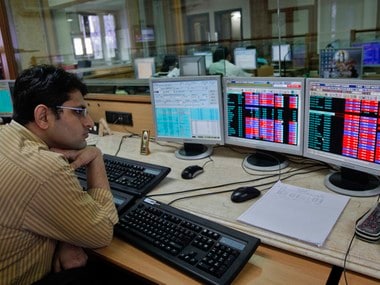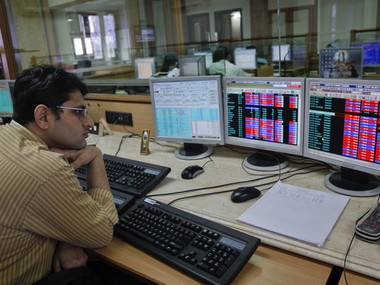Stock Markets LIVE Today Updates: Benchmark indices rebounded in the morning trade as Sensex rose 141.53 points or 0.47 percent to 30,521.34 while the Nifty was up 55.85 points or 0.63 percent at 8,981.15 at around 11.30 am. L&T, ICICI Bank, PowerGrid, Nestle India and IndusInd Bank were the top gainers in the Sensex pack. Benchmark indices pare losses; Sensex 96 points down, Nifty above 8,900-level Asian stocks look set to tumble on Thursday, as fears that the world is in its worst recession since the 1930s were heightened by data showing US retailers suffered a record sales collapse in March due to the coronavirus outbreak. E-Mini future for the S&P 500 ESc1 fell 0.76 percent while Nikkei futures NKc1 pointed to a loss of 70 points, mirroring a 2.2 percent decline in the S&P 500 overnight. The flight from risk helped the dollar rebound against major currencies and nudged gold off a 7-1/2-year high, while expectations that a recession will depress demand for oil pushed crude prices to 18-year lows overnight. “The US (and global) economy is in a deep recession,” Kim Mundy, an analyst at Commonwealth Bank of Australia, wrote in a note, adding that a downturn will support the dollar. “The unemployment rate in the United States will almost certainly lift above 10 percent shortly.” Data showed on Wednesday that US retail sales had plunged 8.7 percent in March, the biggest drop since the government started tracking the series in 1992. Output at factories was also shown to have declined by the most since 1946. [caption id=“attachment_4472957” align=“alignleft” width=“380”]  Representational image. Reuters.[/caption] The United States is set to release its weekly jobless claims data on Thursday and the market expects a further 5.105 million claims, according to a Reuters poll. The grim outlook was echoed by lenders with major US banks Goldman Sachs Group Inc and Citigroup Inc warning of future loan losses as they posted drops in profits. The coronavirus, which triggers a respiratory illness, has caused two million infections worldwide and over 131,000 deaths, wreaking havoc on the global economy as governments shut schools and businesses and order people to stay home to slow its spread. Though countries including Spain, Italy and Germany are re-opening some businesses, analysts say it is unclear when the global economy will recover to its pre-pandemic days. In the United States, President Donald Trump said he will announce “guidelines” for re-starting the economy on Thursday. Evidence that the global downturn has slashed the demand for oil again drubbed U.S. crude prices. The United States had reported overnight its biggest weekly inventory build on record, following a warning from the International Energy Agency that oil demand will dive 29 million barrels a day in April to levels unseen in a quarter of a century. US crude CLc1 was last up 1.7 percent at $20.23, recovering from an earlier low of $19.51, while Brent crude LCOc1 was down 5.4 percent at $28. Bracing for tough times ahead, investors piled into bonds. The yield on US 30-year Treasury Inflation Protected Securities (TIPS) hit a record low of -0.183 percent, while that of US. 10-year TIPs fell to a seven-year trough of -0.553 percent. US two-year yields were at 0.201 percent after dropping below 0.2 percent for the first time in three years, and 10-year yields US10YT=RR were at a one-week low at 0.635 percent, more than 100 basis points off their January levels. The demand for safety helped the dollar index rise 0.7 percent to 99.564. It was steady against the Japanese yen after gaining as much as 0.25 percent overnight, while the euro recovered to $1.0909, from a low of $1.0859. The Australian dollar, which is leveraged to global growth, was down 0.1 percent at $0.631. A stronger dollar pulled gold prices back from a 7-1/2-year high struck this week, helped by recessionary fears and a tide of cheap money from central banks. It was last at $1,714 an ounce. The International Monetary Fund warned on Tuesday that the world economy is set to shrink by 3% this year in the steepest downturn since the 1930s Great Depression.
Stock Markets Latest Updates: Benchmark indices rebound from early losses as Sensex jumps over 200 points, Nifty close to 9,000-mark
Stock Markets LIVE Today Updates: Benchmark indices pare losses; Sensex 96 points down, Nifty above 8,900-level
)
Sensex jumps over 200 points, Nifty close to 9,000-mark
The market rebounded from the opening losses as the Sensex jumped 222.80 points or 0.73 percent to 30,602.61 while the broader Nifty was up 67.50 points or 0.76 percent at 8992.80 at close.
NTPC was the top gainer in the Sensex pack rising nearly 6 percent. Other gainers included ICICI Bank Titan, L&T, SBI, Sun Pharma, Nestle India and IndusInd Bank.
As many as 1,596 shares advanced, 743 shares declined, and 148 shares remained unchanged during the session.
Except IT and FMCG, all other sectoral indices ended in the green.
#MarketAtClose | Market closes in the green on hopes of fiscal stimulus package by Govt. Sensex & Nifty regain Wednesday’s losses with both indices up 1% each pic.twitter.com/N4bkI2dCTl
— CNBC-TV18 (@CNBCTV18Live) April 16, 2020
‘Index tried to recover early losses’
After a negative opening on back of global cues, the index tried to recover its early losses and gave a sudden spurt on back of its large constituents, said Sumeet Bagadia, executive director, Choice Broking.
“Moreover, most of the time of the first half, the index traded in a range bound move, though after giving a breakout of the same, we saw a high near to 9,090 level. During the trading session, we saw a good move in BankNifty compared to Nifty and settled with the gain of 2.30 percent,” he said.
At present level, the index has good support at 8,800 while upside resistance comes at 9,100, if the Index sustains above 9,100 then we may see an upside movement up to the level of 9,300.
Microsoft adds 5 Indian languages to Microsoft Translator
Microsoft India has announced that Microsoft Translator will now offer real time translation in five additional languages viz., Gujarati, Marathi, Kannada, Malayalam and Punjabi.
This takes the total number of Indian languages supported to 10, including Bengali, Hindi, Tamil, Telugu, and Urdu. With this, the service will now allow over 90 percent of Indians to access information and work in their native/preferred languages, making computing language-agnostic and more inclusive in the country.
Users can avail the benefits of AI and Deep Neural Networks-enhanced, real time translation in all these languages whileusing Bing and the Microsoft
Translator website, as well as the Microsoft Translator App for Android, IOS and Windows. The Microsoft Translator app can recognise and translate languages from text, speech and even photos. Microsoft is also rolling out support for these languages in the Microsoft Office 365 and the Swiftkey keyboard.
E-commerce firms likely to resume full operations soon
Sources say e-Commerce companies can sell both essential and non essential goods, reports @Parikshitl pic.twitter.com/TfJRfSkMEf
— CNBC-TV18 (@CNBCTV18Live) April 16, 2020
ICICI Bank deploys two mobile ATM vans in Mumbai
ICICI Bank today announced that it has deployed two mobile ATM vans in Mumbai to bring key banking services to the doorstep of the residents in wake of the coronavirus outbreak.
These vans will be stationed at the various localities in consultations with government authorities from 10 am to 7 pm. So far, residents of Worli, Thane, Dombivali and Goregaon among others have availed the services. The Bank will continue to offer this service till the lockdown continues.
The mobile ATMs will offer all the services that are available at regular ATMs. Apart from cash withdrawals, key services which can be availed by the customers are – transferring funds to registered payee, change of PIN, recharge pre-paid mobile, book fixed deposits, among others.
Life sciences firm Hikal contributes Rs 1 cr to PM-CARES Fund
Global life sciences company Hikal on Thursday said it has contributed Rs 1 crore to the PM-CARES Fund to aid the government’s initiatives in fighting against the deadly COVID-19.
The company also announced that its employees have voluntarily pledged their one-day salary towards Chief Minister’s Relief Fund of Maharashtra, Karnataka and Gujarat.
The company would also add a sizable amount to the funds pledged by its employees, Hikal said.
The company has also contributed for the well-being of healthcare service providers, corporation staff, affected daily wage workers and the underprivileged community around the Hikal plants in Maharashtra, Karnataka and Gujarat.
India’s sugar export, domestic sales hit due to lockdown: ISMA
India’s sugar sales in both domestic and overseas markets have taken a beating in view of the nationwide lockdown imposed by the government for preventing the spread of the deadly COVID-19, industry body ISMA said on Thursday.
However, fall in overseas sales of sugar during the lockdown is expected to ‘partially or largely’ get compensated by the extra sales to Indonesia, which is likely to meet its sugar demand from India in view of shortages in Thailand, it said.
Meanwhile, the country’’s total sugar production has reached 24.78 million tonne till 15 April of the 2019-20 marketing year (October-September), down by 20 percent from 31.17 million tonne in the year-ago period, it added.
“The exports have been affected due to sudden drop in global sugar prices, but the recent depreciation of rupee is giving some relief to the exporters,” Indian Sugar Mills Association (ISMA) said in a statement.
China central bank will continue to support smaller firms
China’s central bank said on Thursday it will continue to guide credit to support the real economy, especially smaller firms, via measures including targeted cuts in banks’ reserve requirement ratios (RRR) and re-lending.
Since early February, the central bank has unveiled a raft of measures from cutting lending rates and making cheap loans at subsidized rates to providing payment relief to firms that have been hardest hit by the coronavirus outbreak and containment measures.
Dollar consolidates gains before US jobless data release
The dollar consolidated its gains against other currencies on Thursday before the release of weekly US jobless data, which are likely to provide more evidence of a deep recession in the world’s biggest economy.
The dollar edged up 0.1 percent to 99.774 against a basket of major currencies, after snapping a four-day losing streak the previous day as equity market gains hit a wall.
However, stabilising oil prices and some improvement in risk sentiment on stock markets helped temper the dollar’s gains.
Economists forecast US weekly jobless claims of 5.1 million, lifting total filings during the crisis above 20 million.
Infosys to announce Q4, annual results on 20 April
. @Infosys Infosys to announce fourth quarter and annual results on April 20 pic.twitter.com/QzO6D6trIA
— CNBC-TV18 (@CNBCTV18Live) April 16, 2020
Cargill India to provide 16 mn meals, donates to PM CARES Fund
Cargill India, which is part of US food major Cargill, on Thursday said it has donated contributed to PM-CARES Fund to support the fight against coronavirus and, will provide 16 million meals to feed the most vulnerable sections of the society.
Cargill India has a presence in India since 1987 and sells wheat flour under the ‘‘Nature Fresh’’ brand. It markets edible oils under various brands such as Nature Fresh, Gemini, Sweekar, Leonardo Olive Oil and Rath.
“COVID-19 continues to spread, there is a growing need to feed the most vulnerable communities in our society. In line with its purpose of nourishing the world, Cargill has pledged 16 million meals to feed families through dry ration kits and cooked meals,” Cargill India said in a statement.
IndusInd Bank pledges Rs 30 cr towards COVID-19 relief efforts
Private sector lender IndusInd Bank on Thursday said it has committed Rs 30 crore towards COVID-19 relief efforts.
The bank did not specify if it is contributing to any corpus like the PM CARES Fund and limited itself to saying that it is working with both the central and state governments to fight the pandemic.
It can be noted that a slew of corporates and banks have announced help to the relief efforts since the outbreak last month.
IndusInd Bank said it has supplied relief materials such as face masks, hand sanitisers and gloves to the affected areas to and is also working on facilitating personal protective equipment (PPE) for medical officials on duty.
It has also been given a mandate of opening an account towards the collection of contributions towards Prime Minister’’s Citizen Assistance and Relief in Emergency Situations Fund (PM CARES Fund), an official statement said.
Sensex soars over 300 points, Nifty reclaims 9,000-mark
The market staged a comeback as Sensex surged 340.19 points or 1.12 percent to 30,720 while while the Nifty was up 107.40 points or 1.2 percent at 9,032.70 at around 2.30 pm.
Govt may come up with norms on refunds for cancelled flight tickets
The civil aviation ministry on Thursday said it is deliberating upon forming a set of guidelines on refunds for flight ticket cancellations due to coronavirus lockdown.
Several people have been complaining on social media as domestic airlines have decided not to give refunds in cash for cancelled flights due to the lockdown and instead issue credit for future travel.
“A video meeting was held (with the airline CEOs). The ministry is deliberating (on guidelines),” said the ministry spokesperson.
Private healthcare sector in financial distress, in need of stimulus: Study
The private healthcare sector in the country is witnessing an unprecedented slowdown due to outbreak of COVID-19 in India and the resultant lockdown, according to a FICCI-EY study.
“The pandemic has caused an adverse impact on the private healthcare sector resulting in 70-80 percent drop in footfall, test volumes and 50-70 percent drop in revenue in last ten days of March that is expected to sustain in month of April with continued lock down,” the study said.
Possible ramp up will be gradual thereafter, taking at least three quarters for return to normalcy, according to the study titled ‘COVID-19 impact assessment for private healthcare sector and key financial measures recommendations for the sector’.
Rupee ends at record low of 76.86
#Rupee ends at record low of 76.86 against the dollar#StayHome pic.twitter.com/aYZFAnypTQ
— CNBC-TV18 (@CNBCTV18Live) April 16, 2020
Lockdown: Britannia utilises 65% of installed capacity
FMCG major Britannia Industries on Thursday said it is now utilising 65 percent of its installed capacity and is “better poised” to tackle challenges in the extended lockdown period.
In a bid to scale up production quickly, the leading food company said it is focussing on stock availability rather than consumer demand with staple stock keeping units (SKUs) being preferred rather than those SKUs which demand labour intensity in order to optimise limited available manpower.
“While the business dynamics has changed in the last few weeks, we are now better poised to tackle the situation. With close to 65 percent manufacturing capacity utilisation till now, we have stepped up efforts to address the challenge of inadequate labour in our factories,” Britannia Industries Managing Director Varun Berry told PTI.
He was responding to a query on the company’s preparedness for the extended lockdown.
IEX contributes Rs 5 cr to PM CARES Fund
The Indian Energy Exchange (IEX) on Thursday said it has contributed Rs 5 crore to the PM CARES Fund to support relief measures in the fight against COVID 19 pandemic.
As we face an unprecedented crisis, support and solidarity from citizens as well as corporates during these times will go a long way in supplementing the various efforts undertaken by the government, the IEX said in a statement.
“We are facing one of the toughest global humanitarian and economic crisis. During this time, each one of us must do our part. We acknowledge the all-round efforts of the government and extend our humble contribution to support COVID-19 relief measures,” Indian Energy Exchange CEO and MD Rajiv Srivastava said.
Bosch India pledges Rs 50 cr to combat COVID-19 pandemic
Bosch India on Wednesday said it has pledged Rs 50 crore to combat COVID-19 spread in India.
As a part of its Corporate Social Responsibility initiatives, Bosch Group in India immediately donated Rs five crore to PM CARES FUND and pledged additional Rs 45 crore for various community welfare initiatives, the company said in a statement.
Stating that Bosch India has also started various welfare initiatives to help the underprivileged, it said, the company has been supplying cooked meals from its kitchen in Bidadi plant and through the Art of Living Foundation to about 4,000 migrant workers and other needy individuals, on a daily basis.
Till date, Bosch has already supported around 1,500 needy families by supplying ration packets during the current nationwide lockdown, it added.
Sensex up 223 points, Nifty gives up 9,000-mark
The market trimmed some gains as Sensex was trading 223.45 points or 0.74 percent higher at 30,603.26 while the Nifty was up 72.20 points or 0.81 percent at 8,997.50 at around 2 pm.
Tea auction centre in Guwahati allowed to operate after 20 April
The Guwahati Tea Auction Centre (GTAC) has been permitted to restart operations in a limited manner after 20 April, according to officials.
An order issued by the Kamrup (Metro) administration said e-auctions can begin from 16 April but later deputy commissioner Biswajit Pegu directed the centre to begin operations after 20 April, a GTAC official said on Thursday.
Besides the auction centre, permission has also been granted to related stakeholders with certain conditions, according to the order issued by Additional Deputy Commissioner and CEO of Kamrup District Disaster Management Authority Chinmoy Nath.
Emami forays into hand sanitiser segment under BoroPlus brand
Kolkata-based FMCG major Emami Ltd on Thursday announced its foray into the hand sanitiser segment in the wake of coronavirus pandemic with the launch of the disinfectant under its flagship skincare brand BoroPlus.
Emami has prioritised the launch of this hand sanitiser, an essential commodity in midst of the COVID-19 pandemic, ensuring maximum available production capacity to bring this product to consumers in the shortest possible time given the dire need for the same, the company said in a statement.
The BoroPlus Advanced anti-germ hand sanitizer, powered by natural antiseptic qualities of neem and tulsi, has an alcohol base of 70 percent and is clinically proven to kill 99.99 per cent of illness-causing germs within seconds, Emami claimed.
Domestic equities recover led by gains in US markets
Indian markets have recovered and are trading in the green with gains of almost a 1 percent, following a weak opening mainly led by a recovery seen in the US markets Dow Futures which is trading with gains of 0.80 percent, said Aditya Agarwala, Senior Technical Analyst, YES Securities.
“Further, broader markets continue to outperform the headline indices for second day in a row, both Midcap and Smallcap Indices are up between 1.4 percent-1.8 percent respectively. Sectoral gainers are pharma, metal and realty,” he said.
IT sector is under pressure as the results of IT majors starts to trickle in. Nifty, if continues to sustained above 9,025 can witness more short covering rallies to levels of 9130-9300, Agarwala.
“On the downside immediate supports are at 8,900-800. European markets are also suggesting a positive start. All the three major Indices i.e. FTSE, CAC and DAX are trading with gains in excess of 0.6 percent,” he said.
Benchmark indices stay in green zone as Sensex jumps 322 points
The market continued to trade in the green zone as Sensex surged 321.84 points or 1.06 percent to 30,701.65 while the Nifty was up 83.35 points or 0.93 percent at 9,008.65 at around 1.15 pm.
MG Motor India ties up with Medklinn for vehicle cabin sterilisation
MG Motor India on Thursday said it has partnered with Singapore-based Medklinn to explore natural sterilisation of cabin air and surfaces in its cars.
The carmaker said it will evaluate the viability of installing Medklinn’’s patented cabin sterilisation technology, Cerafusion, in its India products, the HECTOR and the ZS EV.
The coronavirus pandemic has raised the need for having sterilisation and disinfection features in vehicles.
“As part of our commitment to innovation and safety, we are partnering with Medklinn, one of the top global players in this domain, to explore world-class cabin sterilisation solution in our vehicles,” MG Motor India President and Managing Director Rajeev Chaba said in a statement.
Maruti Suzuki gains 4% in afternoon trade
#CNBCTV18Market | Maruti Suzuki gains 4% from lows pic.twitter.com/kQhAcd7ZOA
— CNBC-TV18 (@CNBCTV18Live) April 16, 2020
Toyota comes out with restart manual for manufacturing sector
Toyota Kirloskar Motor said on Thursday it has during the lockdown period used its years of knowledge, expertise and access to global best practices to
devise a comprehensive ‘restart manual’ as a guide for industries to follow post the withdrawal of the curbs.
With an intent to support the manufacturing sector, TKM had put together a team of cross-functional experts to go into minutest details of various operations and create a standard operating procedure that would ensure the “safest possible” restart to manufacturing by securing the workers from any health hazards, a company statement said.
“This manual is in consonance with the broad government guidelines that have been issued and will be used by TKM, its suppliers and has also been shared as a reference document with all Automotive Component Manufacturers Association of India (ACMA) members. TKM also intends to share it with wider segment of industry through industry association platforms like CII,” it said.
Japan PM leans toward blanket cash payouts
Japanese Prime Minister Shinzo Abe has decided to change a draft supplementary budget to allow blanket cash payouts to all citizens, a government official said, as the coronavirus pandemic bites deeper in the world’s third-largest economy.
Under the current supplementary budget plan, the government sets aside money to fund cash payouts of 300,000 yen ($2,784) but only for households whose income is judged to have been hit by the coronavirus.
Abe’s administration will change the plan and instead deliver 100,000 yen each to every citizen, the official with direct knowledge of the matter told Reuters.
The change would be a nod to growing calls from ruling and opposition lawmakers for Abe to take bolder steps to soften the economic blow of the coronavirus, such as by handing out more cash to more people.
Sri Lanka reduces banks’ emergency funding rate for the first time since 2003
Sri Lanka’s central bank said on Thursday it will immediately adjust its bank rate, the emergency funding rate for commercial banks, to 10%, an effective reduction of 500 basis points, to align it with falls in key rates since last May. The move underlines efforts by policymakers globally to provide support to economies hit by the coronavirus crisis.
The bank rate has been at 15 percent since August 2003 and this is the first time since then that any adjustment in being made.
The bank rate is the emergency rate at which the Central Bank of Sri Lanka (CBSL) provides credit to commercial banks against acceptable collateralised assets.
It acts as a penalty rate, which is higher than other market rates and is known as a Lender of Last Resort rate at which emergency loans are provided to banks.
IndusInd Bank extends support to COVID-19 relief work
IndusInd Bank has been working with the government and its agencies across several states as well as at the national level, in their efforts to fight against the COVID-19 pandemic. IndusInd Bank has committed Rs 30 crore towards this cause and is monitoring the requirements closely.
As part of the commitment, the bank has already supplied relief materials such as face masks, hand sanitisers and gloves to the affected areas to combat the Corona Virus pandemic. The Bank is also working on facilitating personal protective equipment (PPE) for medical officials on duty.
The bank has been given a mandate of opening an account towards the collection of contributions towards ‘Prime Minister’s Citizen Assistance and Relief in Emergency Situations Fund’ (PM CARES Fund).
Grocery shops hike prices on supply crunch
Transportation issues, storage facilities, labour shortage causing short supply of flour, pulses in markets; sources tell @PriyaSheth7 kiranas are hiking prices. Here are more details pic.twitter.com/4TEH8J5QSA
— CNBC-TV18 (@CNBCTV18Live) April 16, 2020
Govt sets foodgrain production target at record 298.3 mn tonne
The agriculture ministry aims to increase foodgrain production by 6.35 million tonnes to record 298.3 million tonnes in the 2020-21 crop year riding high on hopes of normal monsoon.
The foodgrain output in the 2019-20 crop year (July-June) is estimated at an all-time high 291.95 million tonnes, as per the second advance estimates released by the ministry in February.
“IMD has forecast the June to September southwest monsoon rainfall over the country as a whole is likely to be normal. This augurs well for rain-fed kharif crops,” Agriculture Commissioner SK Malhota said at a national level video conference organised to plan for sowing of kharif (summer) crops.
In view of COVID-19 lockdown, Malhotra informed state governments about the exemptions given for farm activities and the need to follow social distancing and sanitisation during the sowing of kharif crops.
Motherson Sumi to raise up to Rs 500 cr via issue of securities
Auto component maker Motherson Sumi Systems on Thursday said its board has approved to raise up to Rs 500 crore through issue of securities.
The company, however, did not disclose the reasons for raising the capital.
The committee of directors (administrative matters) of the company’s board in its meeting held on April 16, has approved the issuance of listed, secured, redeemable, non-convertible debentures (NCDs), with an aggregate amount up to Rs 500 crore on a private placement basis in one or more tranches, Motherson Sumi Systems Ltd (MSSL) said in a regulatory filing.
Dutch new unemployment claims soar 42%
The number of people filing for unemployment benefits in the Netherlands soared 42 percent in March as many businesses were shut down in an attempt to contain the spread of the coronavirus in the country.
The Dutch federal employment agency on Thursday said it had paid benefits to 37,800 new unemployed in March, an increase of 11,200 from the month before.
The strongest increases were among people who used to work in restaurants and bars and among people under 25 years of age, the agency said.
Market extends gains as Sensex surges over 300 points, Nifty holds 9,000-level
Benchmark indices extended the gains as Sensex surged 311.55 points or 1.03 percent to 30,691.36 while the broader Nifty was up 97.90 points or 1.1 percent at 9,023.20 at around 12.40 pm.
European markets open higher
#CNBCTV18Market | European markets open trade with gains pic.twitter.com/O6aA9cxVwW
— CNBC-TV18 (@CNBCTV18Live) April 16, 2020
L&T wins ‘significant’ contracts in January-March quarter
Larsen & Toubro on Thursday said its heavy engineering arm has won ‘‘significant’’ contracts in the January-March quarter of this year including a coal gasification project.
Though the company did not specify the exact amount of the orders, an order under the ‘‘significant’’ category ranges between Rs 1,000 crore and Rs 2,500 crore.
“The unit secured orders for key gasification equipment from Wuhan Engineering Ltd, China against stiff Chinese competition for Talcher Fertilizer, which is the first-of-its-kind Coal gasification project in India. It will produce 1.27 MTPA (million tonne per annum) of Urea through the gasification of the mixed feedstock of Indian coal with high ash content and pet coke,” the company said in a statement.
L&T Heavy Engineering has already delivered key gasification equipment for Indian, Chinese and Vietnam markets in the past.
Sensex jumps over 250 points, Nifty above 9,000-mark
Benchmark indices continued the rally in the afternoon trade as Sensex jumped 277.11 points or 0.91 percent to 30,656.92 while the broader Nifty was up 88.45 points or 0.99 percent at 9,013.75 at around 12.15 pm.
Real estate industry sentiment plunges to record low during January-March: Survey
The real estate industry sentiment plunged to an all-time low during January-March as stakeholders turned pessimistic, foreseeing an adverse impact of the COVID-19 pandemic on demand-supply and liquidity in the market, a survey showed.
According to property consultant Knight Frank and industry bodies FICCI and Naredco, the real estate sector, which showed signs of revival during the October-December quarter of 2019, has suffered a huge setback because of the COVID-19 crisis with both current and future sentiment index falling to an all-time low in pessimistic zone.
“With the crisis playing havoc on the economy and real estate sector, the current sentiments of the real estate stakeholders in India have dropped to an all-time low of 31 in the first quarter (January – March) 2020,” said the 24th Knight Frank-Ficci-Naredco Real Estate Sentiment Index Q1 2020 Survey report.
Market rebounds as Sensex rises 141 points, Nifty above 8,950-mark
Benchmark indices rebounded in the morning trade as Sensex rose 141.53 points or 0.47 percent to 30,521.34 while the Nifty was up 55.85 points or 0.63 percent at 8,981.15 at around 11.30 am.
L&T, ICICI Bank, PowerGrid, Nestle India and IndusInd Bank were the top gainers in the Sensex pack

Chennai Ranks #1 in Challan Checks: ACKO Insights for Smarter Car and Two Wheeler Insurance Decisions
Chennai leads India in challan checks, with drivers checking their e-challans over 5 times a month on average. Helmet non-compliance is the most broken rule, accounting for 34.8% of all traffic offences in Chennai. Regular digital challan checks help drivers avoid hefty fines, promote safe driving, and improve insurance premiums.
More Impact Shorts

)
)
)
)
)
)
)
)
)
)



